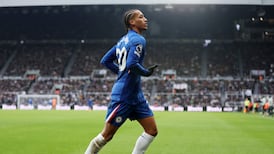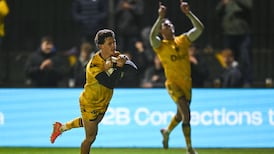Lionel Messi's storming assault on what is possible with a football has drawn many comparisons to what Steph Curry is right now doing in the world of basketball. It's no surprise that the pair have already acknowledged the other's celestial gifts through well-publicised exchange of signed shirts; a nice touch, which, of course, can't hurt the shirt sales in their respective clubs, Barcelona FC and Golden State, the reigning NBA champions.
In the two weeks Curry was forced to sit out with injury, the NBA playoffs were merely very good. Curry’s return on Wednesday night restored the season-long state of general jaw-dropping amazement. It wasn’t that he hit 40 points in the Warriors overtime win against Portland, it was that 17 of those came in the five-minute period of overtime. Just like that, Curry set another new NBA record and again made fans wonder if he is the best basketball player ever.
The NBA has been transformed into such a glossily produced transcontinental entertainment that the basic underlying fact of it is often forgotten: it is brutally taxing on the players– 82 games in the regular season and a further 28 for the eventual finalists; far, far too many, played across a huge continent.
It is easy to fall between the cracks, even for the anointed players. Curry was drafted seventh in the NBA draft in the summer of 2009. Among the players ahead of him that year was Jonny Flynn, whose NBA story reads like a terrifying cautionary tale.
Flynn had a good first season with Minnesota, an injury-destroyed second; suffered a slump in form and found himself an add-on in a disconcertingly swift series of trades which ultimately bounced him out of the NBA to play ball in China. He was last seen playing for a team in Italy, whom he left after two games.
Twilight world
The rootlessness – and ruthlessness – of American sport is one of the reasons it is so fascinating and there is a convincing argument to be made that NBA players, particularly in their first years, inhabit a twilight world of hotel rooms and moving on much like Lee Child’s hero, Jack Reacher. It is easy to fall out of view.
Curry was a slightly precarious case just four years ago, when a ligament injury reduced his appearances to 26 games in the entire season and his scoring average to 14 points. Anonymous, in other words.
Curry’s physique was identified early on as a potential hindrance to his basketball career. It was his frame – he was Michael Jackson-skinny leaving high school – that dissuaded Virginia Tech from taking Curry on scholarship, even though his father Dell was feted as an all-time basketball star in the college. Nostalgia extended as far as an invitation to play as a walk-on but not to the financial commitment of a full scholarship. Curry went instead to Davidson college to play point guard, under coach Bob McKillop.
One of the least known but most impressive Irish sports stories involves McKillop travelling to Sligo town to recruit a local player he had heard about through rumour, basically. Michael Bree became the first ever Irish basketball player to be offered a division one scholarship. He went; he captained the team, he was named Davidson MVP for the 2001/02 season. He played starting point guard in games at Cameron Hall in Duke and in Chapel Hill; the high altars of college basketball.
To make the leap from playing ball in Sligo to that otherworld remains a staggering achievement. It was a point made by the Charlie Pierce in a feature he wrote for Esquire titled "Opposite Ends of the Earth" featuring Bree and Lamar Odom. "After all, Bree's high school team practiced twice a week," he wrote of the Irish player's days in Summerhill. "His club team, the Sligo All-Stars, who are something of a dynasty in the limited history of Irish basketball, practised three times a week. That's not even a good afternoon for the kids who play in New York."
You ought to be hot-housed in basketball from a tender age just to have a hope of playing division one. Yet in 2002 an Irish man held the point guard role Steph Curry would take up just four years later.
Nobody was expecting Curry to do what he did then. Even after 2008, when his three-point shooting carried Davidson on a thrilling run through the NCAA tournament, few figured he would be able to take over the NBA. In pure cold titles, Curry has still a long way to travel before he joins the all-time winners list. All of basketballs’ totemic figures – Bill Russell, Bird, Magic, Kareem – have one thing in common: size. Michael Jordan was a 6ft 6in powerhouse and simply of the great ball sport athletes.
Leaden-footed
Curry looks what he is: a very slender 6ft 3in. He can outmuscle practically nobody. Instead he has to use his speed, mesmerising ball skill, and a series of feints and ball fakes and uncanny drop steps that make exceptionally quick defenders – some of the quickest professional athletes in any ball sport – look leaden-footed and clumsy, almost as if they are moving through water to his fresh air.
And on top of all that, he shoots the basketball with such quickness and accuracy and effortlessness and from a greater distance than anyone – anyone – has ever done before. Mad as those flawless bombs are, it is Curry’s artful, floating close-range shots over the seven-foot giants that truly bamboozle the mind. He shouldn’t be able to get those shots off let alone score them.
There is truth in the argument that had Curry been playing in the 1980s or 1990s, he would simply have been clobbered every time he attempted to take the ball to the basket: that teams of the Pistons or the Knicks or the Celtics simply would crushed and stomped on his artistry. Those were darkly intense teams in a brooding era of NBA basketball.
Curry makes the game appear to be a carnival; watch Jordan’s celebrate killer scores and you see a carnivore in his element; watch Curry and you see someone who is utterly serene and unfazed by the storm he has created. When he went off-the-charts in February against Oklahoma with his 12 three-pointers in a 46-point haul, LeBron James joined the general celebration, tweeting: “Never before seen someone like him in the history of ball.”
Magic Johnson reckoned Curry could become the greatest ball player of all time – if he can keep playing at this level for another four years. Win titles, in other words. His game is so sinewy and gossamer light that it is impossible to imagine him keeping this up through four more gruelling seasons.
What’s already clear is that he plays the game in a way that is uniquely his. Right now, Steph Curry is the genie out of the bottle.











